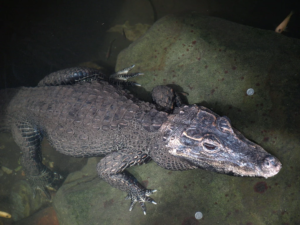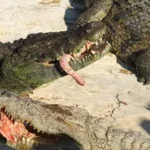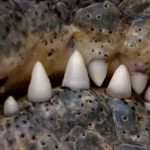Small crocodiles are quite intriguing animals. Let us together learn some facts about these creatures
Small crocodiles exist and occupy tropical areas and are often confused with alligators. This is because alligators are smaller than most crocodiles. However, it is easy to differentiate between the two by looking at their snout: crocodiles have pointed snouts, whereas alligators have rounded snouts.
We are sure you are curious to know more about small crocodiles, their types, habitat, and potential predators. So, together, we can delve deeper into this discussion.
Small crocodiles types
The word crocodiles and small may sound paradoxical, but these two exist together. Let us tell you all about small crocodile types.
There are various types of small crocodiles found around the globe. Some of them include:
- Dwarf Crocodiles
- Cuban Crocodiles
- New Guinea Crocodile
- Orinoco Crocodile
- Philippine Crocodile
- Morelet’s Crocodile
- Smooth-fronted Caiman
Needless to say, these small to medium-sized animals have intrigued scientists and researchers, who are curious to know more about how they survive in the wild, whether they fall prey to attacks by larger crocodiles, and how they hunt for themselves.
Despite their small size, these small crocodile species are quite efficient. Usually, the female species are smaller than their male counterparts.

Image Credits: “Dwarf Crocodile – Ankasa – Ghana 14_S4E1987” by fveronesi1 is licensed under CC BY-SA 2.0.
What is the smallest known crocodile in history?
Now that you know that there are a wide variety of small crocodile species, you may be curious to know which one of them is the smallest. So, here’s the answer.
The West African Dwarf Crocodile happens to be the smallest known crocodile in history. They merely grow up to 5.9 feet and are mostly found in the holes and burrows of tree branches at the edge of the waters. Besides, you will find them in mangrove swamps and in the streams and rivers of west Africa.

Image Credits: “Cuban crocodile (Crocodylus rhombifer)” by warriorwoman531 is licensed under CC BY-ND 2.0.
This crocodile species is more active during the night as they move around in search of food which includes lizards, water birds, shrews, and other insects.
Are small crocodiles dangerous?
Are you wondering whether small crocodile species are as dangerous as the larger ones? Allow us to tell you more in this regard.
Small crocodiles are dangerous and can be as aggressive as large crocodiles. The bite from smaller ones isn’t as painful as one from the larger ones, and most crocodiles between 2 to 3 feet are usually involved in nonfatal attacks. Species like dwarf crocodiles aren’t large enough to view humans as prey.
We must add here that larger crocodile species like the Nile crocodile and saltwater crocodile are far more dangerous to humans. Apart from these, the American crocodile, Mugger crocodile, and Gharial are also quite dangerous to human beings. Alligator species such as the American alligator are also a huge threat to humans.

Image Credits:”Small Crocodile” by abbeyman2002 is licensed under CC BY 2.0.
What do small crocodiles eat?
Curious to know what small crocodile species feed on? Here are some of their favorite food choices.
Small crocodiles are carnivores and eat various animals. Here’s a list of some of their favorite food items:
- Insects
- Fishes
- Small frogs
- Small mammals
- Crustaceans
- Shrews
- Water birds
- Lizards
Crocodiles kept in captivity are usually fed insects and fish, which are placed in water. The crocodile is then encouraged to hunt down these animals. We must add here that small crocodiles do not obviously prey on large animals, and instead, they have to move around at night to catch smaller animals like water birds, lizards, etc.
Can small crocodiles be tamed?
Small crocodiles may appear harmless and easy to tame. But, is it possible to tame them, or are appearances deceptive? Let us find out.
Crocodiles, whether big or small, can’t be tamed. We must remember that they are essentially wild creatures that thrive best when left in the wild. Besides, crocodiles are quite unpredictable and dangerous, and although they have been kept in captivity, it is best to leave them in their natural habitat.
It is interesting to note that the lifespan of a crocodile is greatly improved if they are kept in captivity where the exact conditions of their natural habitat are replicated. As such, crocodiles may often be kept in sanctuaries and conservatory parks. However, regardless of their size, individuals cannot tame them.
Who eats small crocodiles?
Wondering whether small crocodiles are consumed by any sea animals? Allow us to tell you all about it.
Baby crocodiles fall prey to several animals, including wild pigs, larger crocodiles, eagles, herons, large felines such as jaguars and tigers, and large pythons. Needless to say, baby crocodiles are quite vulnerable to attacks by much larger animals due to their small size.
We must add here that most animals avoid preying on crocodiles since it puts them at risk of being attacked. However, small crocodiles may appear not so dangerous to predators, and they may attack them if no other options are available.
Where do small crocodiles live?

Image Credits: “CUBAN CROCODILE” by cuatrok77 is licensed under CC BY-SA 2.0.
Small crocodiles occupy several regions around the world. Let us quickly look at some of the places they can be found in.
Small crocodiles are found in mangrove swamps, wetlands, rivers, streams, and saltwater regions rainforests. They are found in tropical countries such as Asia, Africa, and so on.
As we have mentioned earlier, small crocodiles prefer tropical climates since they are cold-blooded animals and cannot generate body heat on their own. As such, they need to alternate between land and river.
Conclusion
Crocodiles, even smaller species, have tremendous biting power and strength. This helps them ward off any potential predators and navigate between ocean and land with ease. Most small crocodiles can live anywhere between 50 to 100 years, with their lifespan being longer if they are kept in captivity.




